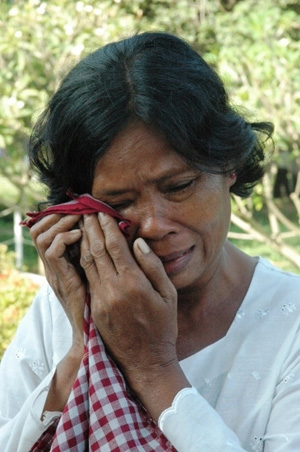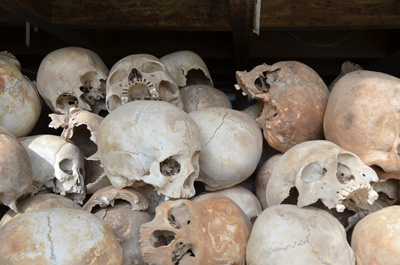Shackles of a brutal past
Decades after the brutal reign of the Khmer Rouge, many Cambodians living in the countryside are still trying to come to terms with the past
Tibor Krausz
The South China Morning Post, December 13, 2006
Phnom Penh

Past several fenced-off mass graves linked by a meandering footpath in the Khmer Rouge killing fields of Choeung Ek, Chen Van arrives at the centrepiece of the memorial ground – a glass-walled, obelisk-shaped stupa – and stares dumbfounded.
The shy farmer who has travelled far from the southeast by bus to be here gazes at row upon row of human skulls arrayed neatly on wooden shelves, and bursts into tears. Burying her face in her checkered shawl, Chen Van tries in vain to muffle her sobs. Perhaps, she says, some of the disembodied heads once belonged to her three brothers.
Also visiting the memorial is Nguon Bei, from a farming village in the south. He, too, professes to be taken aback by the gruesome sight – for an entirely different reason. He just can’t believe, he says, his old comrades could have done this. A small man with an unruly mop of hair, Nguon Bei wears a faded Unicef shirt with a heart emblazoned on it. Until recently, he was a Khmer Rouge stalwart. “I came here to see those thousands of skulls and hundreds of mass graves people are talking about,” he said furtively.
Choeung Ek is one of Cambodia’s handful of memorials of the Khmer Rouge genocide that, between 1975 and 1979, claimed the lives of nearly two million citizens – a third of the nation’s population then. Chen Van and Nguon Bei – and 396 fellow villagers from across the country – were taken to the city as part of a two-day, educational trip organised and funded by the Documentation Centre of Cambodia (DC-Cam), a leading research institution on the killing fields.
Mention Cambodia, and the image that comes to mind for many is of the estimated 1.7 million deaths wrought on the country by the Khmer Rouge during their brutal reign from 1974 to 79. So it is strange that numerous survivors – and some perpetrators – have yet to learn about the true extent of the killing fields. During the Khmer Rouge era, rural Cambodians were isolated and resigned to fates imposed by tyrannical overlords.
Many still don’t understand why they and their families were condemned to extreme suffering, let alone murder, by the Khmer Rouge who proclaimed themselves the liberators of the dispossessed. And governments in the impoverished nation have done little to educate Cambodians about the period.
“Most survivors living in rural communities have only isolated memories of atrocities,” said Ly Sok Kheang, a researcher for DC-Cam, who is escorting the villagers around memorial sites. “Many don’t even know what happened in neighbouring provinces.”
Every month since February, the research institution, founded by Yale University in 1995, has brought villagers to Phnom Penh in groups of 400 to 500 to show them documentaries, encourage them to share memories, and brief them about UN-sponsored war-crimes tribunals.
“If [the villagers] can witness the enormity of the crimes, they come to finally understand what happened not only to them personally but to our entire nation,” the researcher said.
The planned trial of Pol Pot’s henchmen for the events of more than three decades ago will also boost the nation’s awareness of atrocities, but wrangling over trial rules has hampered proceedings. Last month, foreign prosecutors and Cambodian officials spent a whole week trying to agree on hundreds of rules and guidelines – everything from admissibility of evidence to witness protection to the height of the judges’ chairs – but failed to resolve lingering differences.
A source familiar with the talks told the Reuters news agency that the Cambodian officials – products of a politicised judiciary described by the UN in 1999 as “deficient in most important areas” – simply refused to negotiate. “There was a clear attempt to stall it, which is disturbing,” the source said.
Court spokesman Peter Foster, meanwhile, said that although the Cambodians “spoke with a common voice,” the tribunal’s primary concern was “not to approve anything that violated the Cambodian legal system.” Some observers detected the hand of Prime Minister Hun Sen – a former Khmer Rouge commander not linked to any atrocities – behind the stalling. His critics jumped on the impasse as evidence he had been spooked by the speed and rigour with which Canadian prosecutor Robert Petit was working. Hun Sen, they said, wanted to apply the brakes.

The Extraordinary Chambers in the Courts of Cambodia, as the court is named officially, are mandated only to go after Khmer Rouge “senior leaders” and those “most responsible” for the atrocities committed during Pol Pot’s reign of terror.
After Pol Pot’s death in 1998, that was always assumed to mean “Brother Number Two” Nuon Chea, ex-president Khieu Samphan, ex-foreign minister Ieng Sary and a few others, including Duch, head of the notorious Tuol Sleng “S-21” interrogation centre in Phnom Penh, and military supremo Ta Mok, who died in July. But, the theory goes, perhaps Mr Petit was casting his net a little too wide and a little too close for comfort for a government still laden with ageing Khmer Rouge cadres.
Amid such slow progress, the work of DC-Cam assumes greater importance.
Pol Pot’s peasant army of Maoist guerillas swept into Phnom Penh and immediately imposed their puritanical vision of a classless, agrarian society. Urbanites, labelled “new people”, were herded out into rice paddies to sweat in extreme privation alongside rural “base people.” Intellectuals – teachers, doctors, dance instructors, or anyone wearing glasses – were systematically killed.
In 1979, invading Vietnamese troops ten her killed – everything belonged to Angkar (“the Organisation”). One day in 1976, Chen Van was planting rice shoots when “I saw my brothers being handcuffed and I ran over to them”. She pats her chest gently to fight back renewed sobs. “My oldest brother tried to comfort me. He said, ‘Little sister, we have to go’.”
She was later told her brothers – a rickshaw driver, a fisherman, and a student – had been labelled “enemies of the Revolution” and taken to Toul Sleng, a high-school-turned-prison in Phnom Penh, where inmates were tortured into confessing to trumped-up charges of espionage and sabotage before being killed.
“I still can’t believe I survived,” she said. In a family of seven siblings, only Chen Van and a sister emerged from the destruction and chaos of the era.
Nguon Bei says he and many of his brothers-in-arms had nothing to do with the murder of innocents. “I joined the revolution [in 1976 at age 18] for the good of the country,” he said. “I was just a common foot soldier and was politically indoctrinated.”
He stripped off his black Khmer Rouge uniform in 1998 when Pol Pot died, and insists he has a clear conscience. “I only killed the enemy,” he said, referring to the “Vietnamese aggressors”. But how about all those skulls of his fellow Cambodians displayed at Choeung Ek? Kneading his knuckles, Nguon Bei cringes. “I didn’t know my comrades were killing Khmers behind our backs.”
DC-Cam invites ex-Khmer Rouge soldiers like Nguon Bei on its educational tours to foster reconciliation in villages where victims and their former tormentors often live side by side, the former ostracising the latter in silent but persistent acts of cold-shouldering.
During an earlier group tour, a woman and her one-time torturer – both from the same province – were seated across from each other in a Phnom Penh hotel dining hall. She fixed him with an accusatory glare but said not a word. He bowed his head in shame and whispered apologies.
“Justice”, said DC-Cam’s director, Chhang Youk, a survivor of the killing fields himself and Cambodia’s foremost researcher on the period, “comes in different forms for different people”.
Closure, too, comes in myriad forms. For three decades, Mot Voeun, a diminutive woman, has been waiting for her husband, an erstwhile royalist soldier arrested by the Khmer Rouge.
This morning she saw him again – in a photo displayed in a tableau of inmates’ mug shots at Toul Sleng in the capital, which is now a museum. Just seven of 17,000 men, women, and children brought there survived. What Mot Voeun had always feared but never admitted to herself was true: he was dead.
Tormented by a tragedy that shattered lives and left questions unanswered, survivors often still can’t come to terms with their loss.
“My mother doesn’t want to believe her favourite brother is dead,” said Youk. “I found a forced confession by one of his friends that implicated my uncle, but a fortune-teller has told my mother [that] her brother is alive, so she hopes and hopes, waiting for him to return.” That’s why, he said, education, not just trying a few mass murderers in court, remains crucial. Impoverished Cambodia has a literacy rate of 35 per cent, but there isn’t much to read about the Khmer Rouge period, to begin with.
“The Khmer Rouge are not history; they’re a living reality,” Youk said. “They’re still right here among us.”
Two-thirds of Cambodia’s 12 million citizens were born after the Pol Pot era, so most young Cambodians know little or nothing about the horrors their parents and grandparents experienced. In a 79-page textbook on Cambodian history published for ninth-graders by the Ministry of Education in 2000, the Khmer Rouge era rates two sentences. These have been excised from a later edition.
In an effort to promote awareness of the past, DC-Cam publishes Searching for the Truth, a free monthly that contains testimonials by victims and perpetrators alike, and Youk has drafted a comprehensive textbook about the Khmer Rouge for high school students that awaits government approval and funding. “We’re serving the cause of justice just by teaching history – by remembering and commemorating victims,” he said.
Chen Van agrees. “So many people died … If we let our memories of them fade away, their souls will never be at rest and find their peace.”